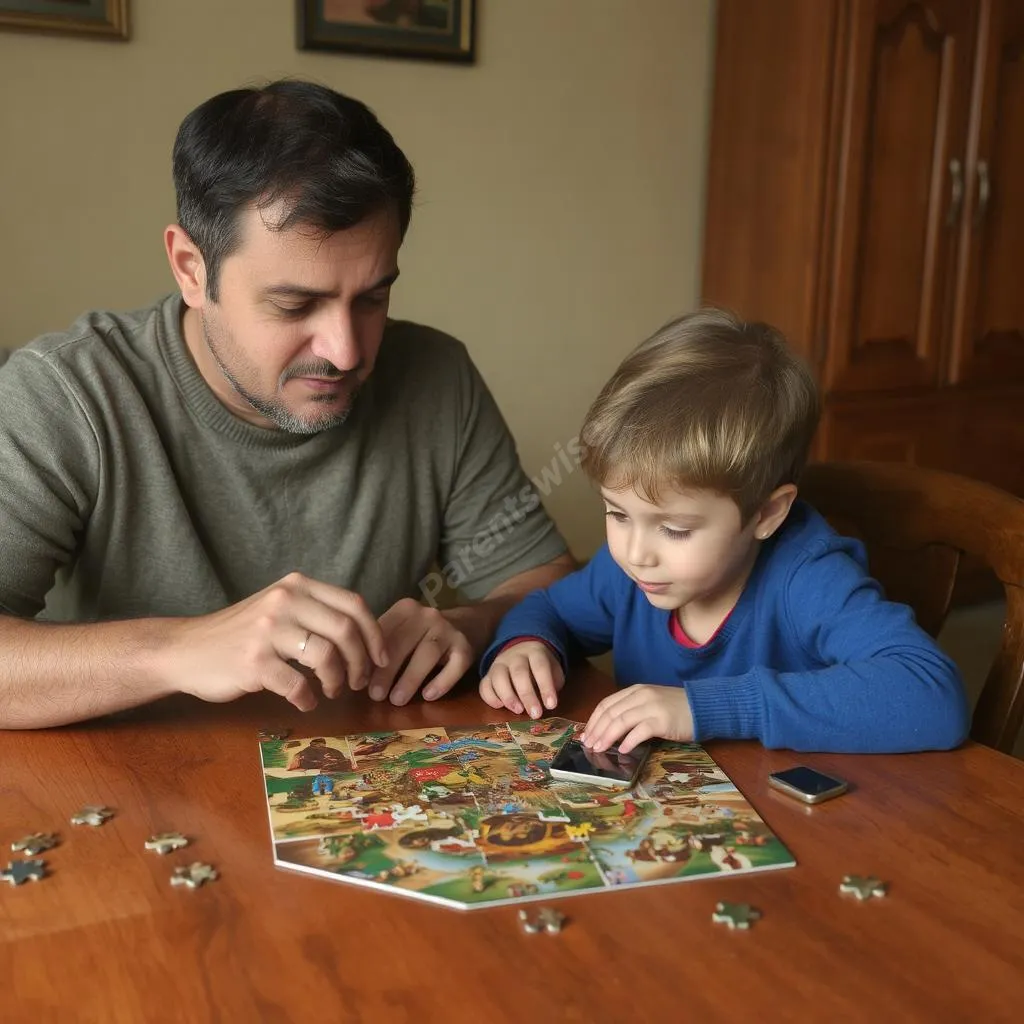8 Strategies to Build Family Resilience: Parent-Child Guide

Did you know that resilient children are 50% more likely to succeed in school? They also maintain healthier relationships throughout their lives. As parents, we want our children to thrive in the face of challenges. In today’s fast-paced world, fostering resilience has become more important than ever.
Resilience is like a muscle that grows stronger with practice. It’s the ability to bounce back from setbacks. It helps us adapt to change and keep going when things get tough. The good news? You can help your children develop this vital life skill. At the same time, you’ll be strengthening your own resilience.
This guide will walk you through 8 practical strategies for building family resilience. You’ll learn how to create a stronger, more adaptable family unit. Together, you’ll be ready to take on whatever life throws your way.
Understanding Resilience in Family Settings
Resilience in families looks different from individual resilience. It’s about how family members support each other during tough times. Family resilience means bouncing back together from challenges.
For children, resilience might look like:
- Trying again after failing a test
- Making new friends after moving to a new school
- Coping with disappointment when they don’t get what they want
For parents, resilience could be:
- Staying calm during a child’s tantrum
- Finding new solutions when old parenting strategies don’t work
- Balancing work and family life during stressful periods
Research shows that resilient families share certain traits. They communicate openly and solve problems together. These families also maintain a positive outlook, even in difficult situations.
Here’s a real-life example of family resilience:
The Smiths lost their home in a natural disaster. Instead of falling apart, they:
- Supported each other emotionally
- Made a plan to rebuild together
- Found strength in their family bond
This experience, though challenging, made their family stronger. They learned they could overcome anything as a team.
Studies have shown that resilient families are better equipped to handle stress. They also have improved mental health outcomes. By fostering resilience, you’re giving your family a valuable tool for life.
Strategy 1: Building Emotional Intelligence
Emotional intelligence is key to resilience. It helps children and parents manage their feelings effectively. Understanding emotions is the first step to handling them well.
Here’s how you can build emotional intelligence in your family:
- Name emotions: Help your children identify what they’re feeling. Use simple terms like happy, sad, angry, or scared. This builds their emotional vocabulary.
- Validate feelings: Show your children that all emotions are okay. It’s how we handle them that matters. Say things like, “It’s normal to feel frustrated when things don’t go your way.”
- Model healthy expression: Show your kids how to express feelings appropriately. Use “I feel” statements when you’re upset. For example, “I feel annoyed when my work is interrupted.”
- Teach coping strategies: Help your children find ways to manage difficult emotions. This could be deep breathing, counting to ten, or taking a short break.

Here are some age-appropriate activities to build emotional awareness:
- For young children (3-6 years):
• Play “emotion charades” – act out different feelings
• Read books about emotions and discuss them
• Use a “feelings thermometer” to measure intensity of emotions - For older children (7-12 years):
• Keep an emotion journal
• Create art projects expressing different feelings
• Discuss emotions in favorite movies or books - For teenagers:
• Practice mindfulness meditation
• Encourage open discussions about complex emotions
• Use mood-tracking apps to identify emotional patterns
Remember, building emotional intelligence takes time and practice. Be patient with yourself and your children. Every step towards better emotional understanding is a win for family resilience.
Strategy 2: Creating Strong Family Bonds
Strong family bonds are the foundation of resilience. They provide a sense of security and support. Family connections help children feel confident to face challenges.
Here are some ways to strengthen your family bonds:
Quality Time Together
Spend regular, dedicated time as a family. This could be:
- Weekly game nights
- Daily family meals
- Weekend outings or activities
Make this time device-free to encourage real connection. Focus on enjoying each other’s company without distractions.
Open Communication
Create an environment where everyone feels safe to share. Try these tips:
- Practice active listening
- Encourage sharing of both positive and negative experiences
- Avoid judgment when family members open up
Family Traditions
Establish traditions that are unique to your family. These could be:
- Annual camping trips
- Special holiday rituals
- Monthly “family fun days”
Traditions create shared experiences and memories. They give family members a sense of belonging.
Trust-Building Exercises
Try these activities to build trust:
- “Trust fall” exercises (with proper safety precautions)
- Sharing circles where each person gets uninterrupted time to speak
- Collaborative projects where family members rely on each other
Show Appreciation
Regularly express gratitude for each family member. This could be:
- A “gratitude jar” where you write and share appreciations
- Nightly “rose and thorn” sharing at dinner
- Writing thank-you notes to each other for small acts of kindness
Remember, strong family bonds don’t happen overnight. Consistently prioritize these activities. Over time, you’ll build a resilient family unit ready to face any challenge together.
Strategy 3: Developing Problem-Solving Skills
Problem-solving is a crucial skill for building resilience. It helps children and parents tackle challenges effectively. Strong problem-solving skills can boost confidence and reduce stress.
Here’s a simple step-by-step approach to problem-solving:
- Identify the problem
- Brainstorm possible solutions
- Evaluate each solution
- Choose the best solution
- Implement the solution
- Reflect on the outcome
Teaching this process to your children can help them become independent problem-solvers. Start with simple problems and gradually increase complexity.
Age-appropriate problem-solving techniques:
For young children (3-6 years):
- Use picture cards to illustrate problems and solutions
- Role-play simple problem scenarios
- Read stories about characters solving problems
For older children (7-12 years):
- Encourage them to write down their problems and potential solutions
- Use decision-making trees for more complex issues
- Introduce the concept of pros and cons for each solution
For teenagers:
- Teach critical thinking skills to evaluate different solutions
- Encourage them to research and gather information before deciding
- Discuss hypothetical scenarios to practice problem-solving skills

Real-life application opportunities:
- Let children plan a family outing, solving logistical problems
- Encourage them to find solutions for household challenges
- Allow them to resolve conflicts with siblings independently (with guidance)
Remember, the goal is to guide, not solve problems for them. Offer support, but let your children take the lead. This builds their confidence and problem-solving abilities.
By developing these skills, you’re equipping your family with valuable tools for resilience. They’ll be better prepared to face life’s challenges head-on.
Strategy 4: Establishing Healthy Routines
Healthy routines provide stability and predictability. This is crucial for building resilience. Consistent routines help children feel safe and secure. They also make it easier to cope with unexpected changes.
Here’s why routines are important for resilience:
- They create a sense of normalcy during stressful times.
- Routines help manage anxiety by making the day more predictable.
- They build healthy habits that support overall well-being.
- Consistent routines improve time management and reduce daily stress.
Components of a resilience-building routine:
- Regular sleep schedule
- Balanced meals at consistent times
- Dedicated family time
- Physical activity
- Homework or learning time
- Relaxation or downtime
- Chores or responsibilities
Remember, flexibility within structure is key. Routines shouldn’t be rigid. They should be adaptable to changing circumstances.
Here’s a sample daily routine for a school-age child:
| Time | Activity |
|---|---|
| 7:00 AM | Wake up, morning hygiene |
| 7:30 AM | Breakfast and family check-in |
| 8:00 AM | School preparation |
| 3:00 PM | After-school snack and relaxation |
| 4:00 PM | Homework or learning activity |
| 5:00 PM | Physical activity or playtime |
| 6:00 PM | Family dinner |
| 7:00 PM | Family time (games, reading, etc.) |
| 8:00 PM | Bedtime routine begins |
| 9:00 PM | Lights out |
Tips for establishing effective routines:
- Start small. Introduce one new routine at a time.
- Be consistent, but allow for occasional flexibility.
- Involve children in creating routines. This increases buy-in.
- Use visual aids like charts or calendars for younger children.
- Celebrate when routines are followed successfully.
By establishing healthy routines, you’re providing a strong foundation for resilience. Your family will be better equipped to handle life’s ups and downs.
Strategy 5: Practicing Mindfulness Together
Mindfulness can significantly boost family resilience. It helps both parents and children manage stress better. Practicing mindfulness as a family can create a calmer home environment.
Mindfulness means paying attention to the present moment. It involves observing thoughts and feelings without judgment. This skill can help family members:
- Reduce anxiety and stress
- Improve focus and concentration
- Enhance emotional regulation
- Increase self-awareness
- Promote better sleep
Here are some simple mindfulness exercises for families:
- Breathing Buddies:
Lie down and place a stuffed animal on your belly. Watch it rise and fall as you breathe. This helps focus on breathing. - Mindful Walking:
Take a slow walk together. Pay attention to each step. Notice how your feet feel touching the ground. - Gratitude Practice:
Share three things you’re grateful for each day. This shifts focus to positive aspects of life. - Body Scan:
Lie down and focus on each part of your body, from toes to head. Notice any sensations without trying to change them. - Mindful Listening:
Close your eyes and listen to sounds around you. Try to identify as many different sounds as possible.

Integrating mindfulness into daily life:
- Start meals with a moment of silence to appreciate the food
- Take three deep breaths together before leaving for school or work
- Practice a short meditation before bedtime
- Use mindfulness apps designed for families
Remember, mindfulness is a skill that improves with practice. Be patient and make it fun for everyone. Even a few minutes of mindfulness each day can make a big difference in building family resilience.
Strategy 6: Embracing Failure as Learning
Resilient families view failure as an opportunity for growth. This mindset helps children develop grit and perseverance. It also reduces fear of trying new things.
Here’s how to reframe failure:
- Emphasize effort over outcome. Praise your child’s hard work, not just results.
- Use the word “yet.” When your child says “I can’t do it,” add “yet” to the end.
- Share your own failures. This shows children that everyone faces setbacks.
- Encourage problem-solving after a failure. Ask, “What can we learn from this?”
- Celebrate mistakes as learning opportunities. Say, “Great! You just discovered a way that doesn’t work.”
Parents can model healthy responses to setbacks by:
- Staying calm when things go wrong
- Talking through their problem-solving process out loud
- Showing that it’s okay to ask for help
Here’s a story to illustrate this strategy:
Sarah tried out for the school play but didn’t get a part. Instead of letting her give up, her parents:
- Acknowledged her disappointment
- Praised her courage for trying
- Helped her brainstorm ways to improve for next time
- Encouraged her to help backstage to learn more about theater
This experience taught Sarah resilience. She learned that setbacks are temporary and can lead to new opportunities.
Remember, embracing failure doesn’t mean lowering standards. It means creating a safe space for taking risks and learning from mistakes.
By reframing failure, you’re teaching your children a valuable life skill. They’ll be better equipped to handle future challenges with confidence.
Strategy 7: Building Support Networks
Strong support networks are crucial for family resilience. They provide help during tough times and celebrate successes. Community connections offer different perspectives and resources.
Here’s why support networks matter:
- They offer emotional support when families face challenges.
- They provide practical help, like childcare or meals during busy times.
- They give children a sense of belonging beyond the immediate family.
- They expose families to diverse experiences and viewpoints.
Types of support networks:
- Extended family
- Friends and neighbors
- School communities
- Religious or spiritual groups
- Sports teams or hobby clubs
- Online parenting groups
- Professional support (therapists, counselors)
How to build and maintain support networks:
- Reach out regularly. Don’t wait for a crisis to connect.
- Offer help to others. Support is a two-way street.
- Join local groups or classes that align with your interests.
- Volunteer as a family. This builds community connections.
- Use technology to stay in touch with distant support networks.
Teaching children to seek help:
- Model asking for help when you need it.
- Encourage children to identify trusted adults they can turn to.
- Practice role-playing scenarios where they might need help.
- Praise them when they reach out for support.
Remember, building support networks takes time and effort. Start small and gradually expand your connections. A strong support system can make a big difference in your family’s resilience.
Strategy 8: Maintaining Physical Well-being
Physical health plays a crucial role in resilience. It affects our mood, energy levels, and ability to cope with stress. Prioritizing physical well-being can boost your family’s overall resilience.
Here’s how physical and emotional resilience connect:
- Regular exercise releases feel-good hormones, reducing stress.
- Proper nutrition supports brain function and mood regulation.
- Adequate sleep improves emotional stability and problem-solving skills.
- Physical activity can serve as a healthy outlet for difficult emotions.
Family exercise ideas:
- Go for family bike rides or walks
- Have dance parties in your living room
- Play active video games together
- Try family-friendly yoga or workout videos
- Participate in community sports events
Healthy sleep habits:
- Stick to consistent bedtimes and wake-up times.
- Create calming bedtime routines for both kids and adults.
- Limit screen time before bed.
- Ensure bedrooms are dark, quiet, and cool.
Nutrition basics for resilience:
- Include a variety of fruits and vegetables in meals
- Choose whole grains over refined grains
- Limit processed foods and sugary drinks
- Stay hydrated by drinking plenty of water
- Involve kids in meal planning and preparation

Holistic wellness checklist:
[ ] 30 minutes of physical activity daily[ ] 8-10 hours of sleep per night
[ ] 5 servings of fruits and vegetables daily
[ ] Regular medical and dental check-ups
[ ] Stress-reduction activities (like meditation or hobbies)
[ ] Limited screen time
[ ] Time spent outdoors in nature
Remember, small changes can make a big difference. Start with one area of physical well-being and gradually incorporate others. By taking care of your bodies, you’re building a strong foundation for emotional resilience.
Implementing These Strategies
Putting these resilience-building strategies into practice doesn’t have to be overwhelming. The key is to start small and build up gradually. Here’s how you can begin:
- Choose one strategy to focus on first. Pick the one that resonates most with your family’s current needs.
- Set realistic goals. For example, aim to have one mindful minute each day, rather than a full meditation session.
- Be consistent. Try to incorporate your chosen strategy into your daily routine.
- Involve the whole family. Get everyone’s input on how to implement the strategy.
- Be patient. Building resilience takes time. Celebrate small victories along the way.
Here’s a simple action plan template to get you started:
| Strategy | Action Step | Frequency | Family Member Responsible |
|---|---|---|---|
| Example: Mindfulness | 5-minute breathing exercise | Daily before dinner | Mom leads, all participate |
Choosing strategies based on family needs:
- If your family is going through a big change, focus on building strong family bonds.
- For families dealing with academic pressure, emphasize problem-solving skills and embracing failure as learning.
- If stress levels are high, prioritize physical well-being and mindfulness practices.
Progress tracking suggestions:
- Keep a family resilience journal. Note challenges faced and strategies used.
- Use a sticker chart for younger children to visualize progress.
- Have weekly family meetings to discuss what’s working and what needs adjustment.
- Create a “resilience wins” board where family members can share successes.
Remember, the goal is progress, not perfection. Be flexible and adjust your approach as needed. Every family’s resilience journey is unique.
Conclusion
Building family resilience is an ongoing process. It’s not about achieving perfection, but about continuous growth and adaptation. Let’s recap the key strategies we’ve discussed:
- Building Emotional Intelligence
- Creating Strong Family Bonds
- Developing Problem-Solving Skills
- Establishing Healthy Routines
- Practicing Mindfulness Together
- Embracing Failure as Learning
- Building Support Networks
- Maintaining Physical Well-being
Remember, you don’t need to implement all these strategies at once. Start with what feels most relevant to your family’s current situation. Small, consistent steps can lead to significant improvements in resilience over time.
As you embark on this journey, keep in mind that setbacks are normal. They’re opportunities for learning and growth. Celebrate your efforts, no matter how small they may seem.

Building resilience is one of the greatest gifts you can give your family. It equips your children with valuable life skills. These skills will serve them well into adulthood. At the same time, you’re strengthening your own ability to face life’s challenges.
Remember, every family’s path to resilience is unique. Be patient with yourself and your loved ones. Adapt these strategies to fit your family’s needs and values. With time and practice, you’ll create a more resilient, adaptable, and stronger family unit.
Start today. Choose one strategy and take that first step. Your future resilient family will thank you for it.
Certainly! Here’s a list of all the image prompts mentioned in the article:

